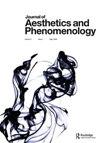Topographic Algorithms: Reimagining Environmental Sensing and Representation
IF 0.2
0 PHILOSOPHY
引用次数: 0
Abstract
forms—as carried through the optical sciences, the striations of cartography, and the diagrammatic reasoning seen in graphs, charts, and, later, databases. Sean Cubbitt’s own genealogy of the graphical line is predicated similarly on its use as a conceptual tool of perceptual and cognitive delimitation and stratification: ‘to abstract form from the manifold of perception, to select and translate reality and the experience of it into signs . . . to extract edges from what can actually be seen: color [sic] and texture. Line is itself an instrument of order, imposed as artifice on a world without lines’. Nevertheless, it is from within this crucible of varied technical, conceptual, and aesthetic striations that alternative imaginaries also become apparent. In Landform, the lines generated by its machine vision routine are largely nonconformal with any particular terrain features, their circuitous vectors being driven by a logic that is expressly nonrepresentational—treating the terrain as a matrix of abstract values, rather than emulating the intuitions of human vision. The effect is to emphasise the enacted nature of such framings within sensory operations, staging the more-than-human functioning of digital perception as the product of computed thresholds that can realise a plurality of forms otherwise unapparent in the source imagery. This is a conscious gesture within Landform towards an expanded conception of visual intelligence more broadly, to invoke Gabrys’ earlier call, while resisting any assumption that digital representations are direct, humanistic captures of the world they depict. Cubitt similarly observes the potential of lines that unsettle the predominant expectations of conformity and demarcation: ‘once the line declares independence from its representational function as edge and takes on a life of its own, it becomes something— albeit not something fixed’. In Landform this sense of becoming is carried through the generated lines functioning not as arbitrary striations across the terrain, but as esoteric algorithms that provide directives for subsequent operations. These programmatic aspects can be characterised instructively through Timotheus Vermeulen’s conception of the ‘altergorithm’: algorithms that aim not to predict and foreclose the future from a defined present, but instead treat the present as a space of becoming from which myriad futures can be facilitated. More specifically, altergorithms concern the production of artistic ‘models that, first, relate to the possibility of a world that develops differently with, or even independently from human interaction; and second, utilize [sic] technocratic models of prediction to envisage these alternative scenarios that defy all prediction’. As with Stubblefield and Parikka’s own conceptions of the role played by art in generating varied possible futures, the emphasis here lies in enacting speculative gestures, alternative narratives, and more-than-human imaginaries that are firmly rooted in established sociotechnical configurations, but which evaluate the vectors of potential within them, however strange or unlikely, and so highlighting their essential contingency. It is in this sense that the programmatic aspects of Landform operate: making manifest the underlying divergence of digital sensing and sense-making from the privileged standpoint of human perception, and, therefore, its capacity for enacting vectors of expression and knowing that are very different from those reproduced by established sensory operations. 238 R. A. CARTER地形算法:重塑环境感知与表征
形式——通过光学科学、地图学的条纹、图形、图表以及后来的数据库中的图解推理来实现。肖恩·库比特(Sean Cubbitt)自己的图形线谱系同样基于它作为感知和认知界定和分层的概念工具的使用:“从感知的多样性中抽象形式,选择并将现实及其经验转化为符号……”从实际可以看到的东西中提取边缘:颜色和纹理。线本身就是秩序的工具,作为一种技巧强加于一个没有线的世界。然而,正是在这个各种技术、概念和美学条纹的熔炉中,不同的想象也变得显而易见。在Landform中,由机器视觉程序生成的线条在很大程度上与任何特定的地形特征都不符合,它们的迂回向量是由一种明显非表征的逻辑驱动的——将地形视为抽象值的矩阵,而不是模仿人类视觉的直觉。其效果是在感官操作中强调这种框架的制定性质,将数字感知的超越人类功能作为计算阈值的产物,可以实现源图像中不明显的多种形式。这是一种有意识的姿态,在Landform中更广泛地扩展了视觉智能的概念,调用Gabrys早先的呼吁,同时抵制任何假设,即数字表示是直接的,人性化的捕捉它们所描绘的世界。库比特同样观察到线条的潜力,它扰乱了对一致性和分界的主要期望:“一旦线条宣布独立于其作为边缘的表征功能,并获得了自己的生命,它就变成了某种东西——尽管不是某种固定的东西。”在《Landform》中,这种生成感贯穿于生成的线条中,而不是像横贯地形的任意条纹那样发挥作用,而是作为为后续操作提供指令的深奥算法。这些程序性方面可以通过Timotheus Vermeulen的“算法”概念来进行有指导意义的描述:算法的目的不是从一个已定义的现在预测和排除未来,而是将现在视为一个可以促进无数未来的空间。更具体地说,算法关注的是艺术模型的产生,首先,它与一个与人类互动不同,甚至独立于人类互动的世界的可能性有关;其次,利用[原文如此]技术官僚的预测模型来设想这些与所有预测相悖的替代情景。”与Stubblefield和Parikka自己关于艺术在产生各种可能的未来中所扮演的角色的概念一样,这里的重点在于制定投机姿态,替代叙事和超越人类的想象,这些想象牢固地植根于既定的社会技术配置,但它们评估了其中的潜力向量,无论多么奇怪或不太可能,因此突出了它们的本质偶然性。正是在这个意义上,Landform的程序性方面发挥了作用:从人类感知的特权立场出发,体现了数字感知和意义构建的潜在分歧,因此,它的表达载体和认知能力与现有感官操作所复制的载体非常不同。238 r. a.卡特
本文章由计算机程序翻译,如有差异,请以英文原文为准。
求助全文
约1分钟内获得全文
求助全文

 求助内容:
求助内容: 应助结果提醒方式:
应助结果提醒方式:


